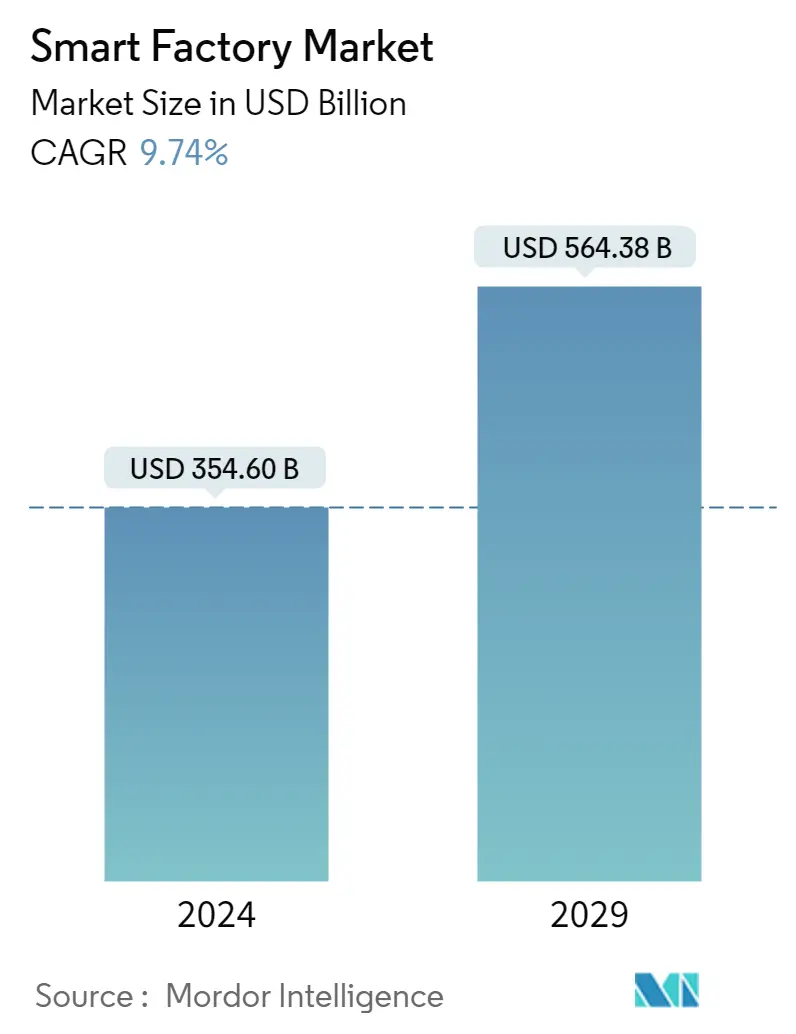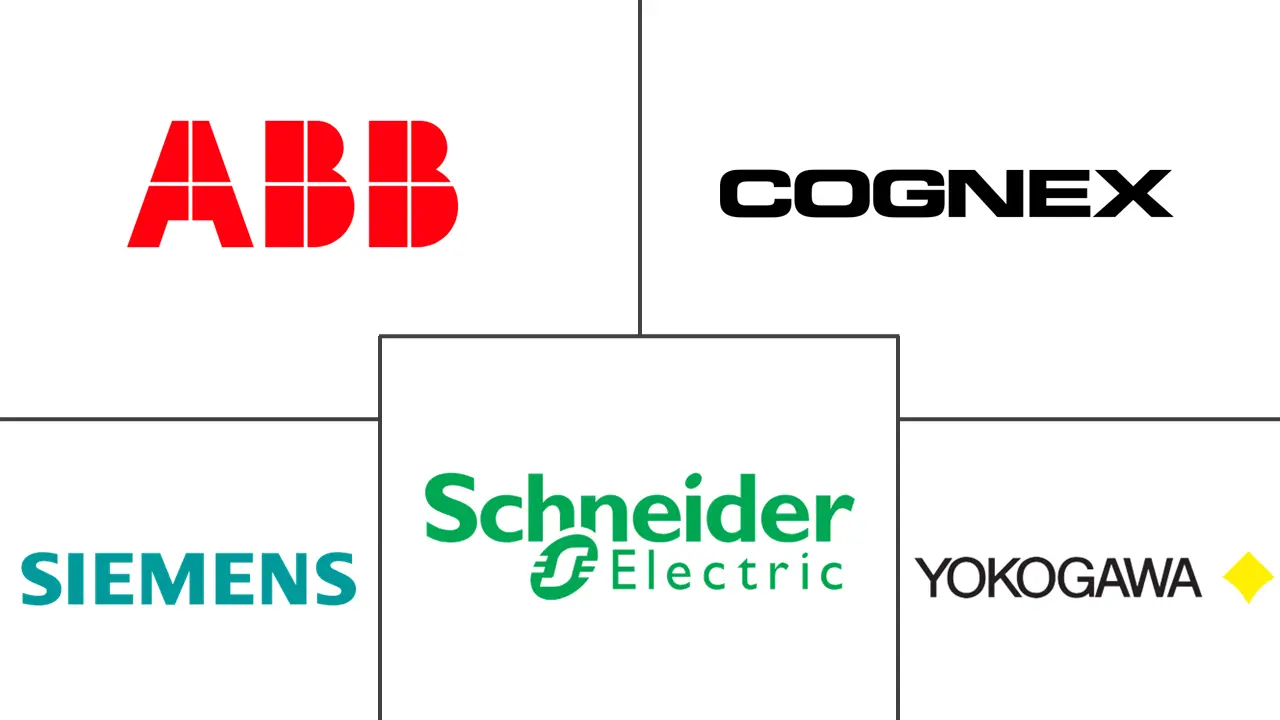Market Size of Smart Factory Industry

| Study Period | 2019 - 2029 |
| Market Size (2024) | USD 354.60 Billion |
| Market Size (2029) | USD 564.38 Billion |
| CAGR (2024 - 2029) | 9.74 % |
| Fastest Growing Market | Asia Pacific |
| Largest Market | Asia-Pacific |
Major Players
*Disclaimer: Major Players sorted in no particular order |
Smart Factory Market Analysis
The Smart Factory Market size is estimated at USD 354.60 billion in 2024, and is expected to reach USD 564.38 billion by 2029, growing at a CAGR of 9.74% during the forecast period (2024-2029).
- Tremendous shifts in manufacturing due to Industry 4.0 and the approval of IoT require enterprises to adopt agile, more innovative, and creative ways to advance production with technologies that complement and augment human labor with automation and reduce industrial accidents caused by process failure. With the increased rate of adoption of connected devices and sensors and the fostering of M2M communication, a surge in the data points that are developed in the manufacturing industry is being observed.
- According to Zebra’s Manufacturing Vision Study, smart asset-tracking solutions based on IoT and RFID overtook traditional, spreadsheet-based methods in 2022. Maryville University calculates that by 2025, more than 180 trillion gigabytes of data are anticipated to be created worldwide yearly. IIoT-enabled industries will generate a large portion of this. In addition, an Industrial IoT (IIoT) company Microsoft Corporation survey found that 85 percent of companies have at least one IIoT use case project. This number increased, as approx 95 percent of respondents implemented IIoT strategies in 2022.
- Incremental advancement in technology, coupled with a sustained increase in the development of manufacturing facilities, is expected to impact the market growth rate during the forecast period. For instance, Intel has recently partnered with Telecom Italia and hardware manufacturer Exor International to develop a smart manufacturing facility that uses artificial intelligence (AI) and 5G networking.
- Furthermore, the glowing market penetration of AI and machine learning (ML) technologies may enhance the accuracy and speed of data analysis, thereby significantly driving the market forward. Moreover, the advancement in the field devices market, robots, and sensors may further expand the scope of the studied market. According to Cisco projections, by 2022, machine-to-machine (M2M) connections that support IoT applications may have accounted for more than 50 percent of the world's 28.5 billion connected devices. Many governments also motivate manufacturing companies to invest in IoT technologies for smart factory adoption, which creates a favorable outlook for the growth of the studied market.
- However, a high installation cost is the primary factor challenging the market's growth. Additionally, the requirement of a highly skilled workforce to operate and maintain the automation infrastructure further adds to the overall cost, restraining mass adoption, especially in small and medium-scale industries.
- Additionally, the recent economic instability, especially as an outcome of the pandemic and geo-political issues such as the US-China trade dispute and the Russia-Ukraine war, is also challenging the studied market's growth as it has not only led to an uncertain business environment across various regions but are also impacting the supply chain of industrial sectors and demand for manufactured products across various region, leading to an unfavorable environment for the studied market's growth.
Smart Factory Industry Segmentation
Smart factory refers to the different fully integrated automation solutions adopted for manufacturing buildings. Such integration helps streamline the material flow during all the procedures involved in manufacturing. Big Data analytics allows factories to use smart solutions in their functions within its premises to shift from reactionary practices to predictive ones. This change targets enhanced efficiency of the process and product performance.
The studied market is segmented by different product types, such as machine vision systems, industrial robotics, control devices, sensors, and communication technologies, among other technologies. The study also considers various end-user industries and multiple geographies. The impact of macroeconomic trends on the market and impacted segments is also covered under the scope of the study. Further, the disturbance of the factors affecting the market's evolution in the near future has been covered in the study concerning drivers and restraints.
The market sizes and forecasts regarding value in (USD) for all the above segments are provided.
| By Product Type | |||||||||
| |||||||||
| |||||||||
| |||||||||
| Sensors | |||||||||
| |||||||||
| Other Product Types |
| By Technology | |
| Product Lifecycle Management (PLM) | |
| Human Machine Interface (HMI) | |
| Enterprise Resource and Planning (ERP) | |
| Manufacturing Execution System (MES) | |
| Distributed Control System (DCS) | |
| Supervisory Controller and Data Acquisition (SCADA) | |
| Programmable Logic Controller (PLC) | |
| Other Technologies |
| By End-user Industry | |
| Automotive | |
| Semiconductors | |
| Oil and Gas | |
| Chemical and Petrochemical | |
| Pharmaceutical | |
| Aerospace and Defense | |
| Food and Beverage | |
| Mining | |
| Other End-user Industries |
| By Geography | ||||||
| ||||||
| ||||||
| ||||||
| ||||||
|
Smart Factory Market Size Summary
The smart factory market is poised for significant growth, driven by the transformative impacts of Industry 4.0 and the integration of IoT technologies. This evolution necessitates manufacturers to adopt more agile and innovative production methods that enhance human labor through automation and improve safety by reducing process failures. The increasing adoption of connected devices and sensors, along with advancements in machine-to-machine communication, is generating vast amounts of data, which is pivotal for the smart factory ecosystem. The market is further bolstered by the growing penetration of artificial intelligence and machine learning, which enhance data analysis capabilities, and the development of advanced devices, robots, and sensors. Government initiatives worldwide are also encouraging the adoption of IoT technologies, creating a favorable environment for market expansion. However, challenges such as high installation costs and the need for a skilled workforce to manage automation infrastructure pose hurdles, particularly for small and medium-sized enterprises.
The semiconductor industry is a key driver of smart factory adoption, with manufacturers leveraging smart manufacturing processes to enhance yields and margins. The rising complexity and connectivity of factories necessitate advanced technologies powered by sophisticated chips. The global increase in semiconductor fabrication plants and the associated investment in new equipment underscore the industry's commitment to smart manufacturing. Government policies in regions like Asia-Pacific, particularly in India and China, are fostering semiconductor manufacturing through financial incentives and support, further propelling the market. The region's focus on smart manufacturing and technology adoption is evident in initiatives like India's National Manufacturing Policy and China's smart manufacturing schemes. Additionally, strategic investments and partnerships, such as those by ABB and Samsung Electronics, are enhancing smart manufacturing capabilities, driving the market forward. The market remains fragmented, with major players like ABB Ltd, Cognex Corporation, Siemens AG, Schneider Electric SE, and Yokogawa Electric Corporation actively pursuing innovations and strategic collaborations to maintain a competitive edge.
Smart Factory Market Size - Table of Contents
-
1. MARKET INSIGHTS
-
1.1 Market Overview
-
1.2 Industry Attractiveness - Porter's Five Forces Analysis
-
1.2.1 Bargaining Power of Suppliers
-
1.2.2 Bargaining Power of Buyers
-
1.2.3 Threat of New Entrants
-
1.2.4 Threat of Substitute Products
-
1.2.5 Intensity of Competition
-
-
1.3 Industry Value Chain Analysis
-
1.4 Assessment of Impact of Macroeconomic Trends on the Market
-
-
2. MARKET SEGMENTATION
-
2.1 By Product Type
-
2.1.1 Machine Vision Systems
-
2.1.1.1 Cameras
-
2.1.1.2 Processors
-
2.1.1.3 Software
-
2.1.1.4 Enclosures
-
2.1.1.5 Frame Grabbers
-
2.1.1.6 Integration Services
-
2.1.1.7 Lighting
-
-
2.1.2 Industrial Robotics
-
2.1.2.1 Articulated Robots
-
2.1.2.2 Cartesian Robots
-
2.1.2.3 Cylindrical Robots
-
2.1.2.4 SCARA Robots
-
2.1.2.5 Parallel Robots
-
2.1.2.6 Collaborative Industry Robots
-
-
2.1.3 Control Devices
-
2.1.3.1 Relays and Switches
-
2.1.3.2 Servo Motors and Drives
-
-
2.1.4 Sensors
-
2.1.5 Communication Technologies
-
2.1.5.1 Wired
-
2.1.5.2 Wireless
-
-
2.1.6 Other Product Types
-
-
2.2 By Technology
-
2.2.1 Product Lifecycle Management (PLM)
-
2.2.2 Human Machine Interface (HMI)
-
2.2.3 Enterprise Resource and Planning (ERP)
-
2.2.4 Manufacturing Execution System (MES)
-
2.2.5 Distributed Control System (DCS)
-
2.2.6 Supervisory Controller and Data Acquisition (SCADA)
-
2.2.7 Programmable Logic Controller (PLC)
-
2.2.8 Other Technologies
-
-
2.3 By End-user Industry
-
2.3.1 Automotive
-
2.3.2 Semiconductors
-
2.3.3 Oil and Gas
-
2.3.4 Chemical and Petrochemical
-
2.3.5 Pharmaceutical
-
2.3.6 Aerospace and Defense
-
2.3.7 Food and Beverage
-
2.3.8 Mining
-
2.3.9 Other End-user Industries
-
-
2.4 By Geography
-
2.4.1 North America
-
2.4.1.1 United States
-
2.4.1.2 Canada
-
-
2.4.2 Europe
-
2.4.2.1 United Kingdom
-
2.4.2.2 Germany
-
2.4.2.3 France
-
-
2.4.3 Asia
-
2.4.3.1 China
-
2.4.3.2 India
-
2.4.3.3 Japan
-
2.4.3.4 Australia and New Zealand
-
-
2.4.4 Latin America
-
2.4.4.1 Brazil
-
2.4.4.2 Argentina
-
2.4.4.3 Mexico
-
-
2.4.5 Middle East and Africa
-
2.4.5.1 United Arab Emirates
-
2.4.5.2 Saudi Arabia
-
2.4.5.3 South Africa
-
-
-
Smart Factory Market Size FAQs
How big is the Smart Factory Market?
The Smart Factory Market size is expected to reach USD 354.60 billion in 2024 and grow at a CAGR of 9.74% to reach USD 564.38 billion by 2029.
What is the current Smart Factory Market size?
In 2024, the Smart Factory Market size is expected to reach USD 354.60 billion.

